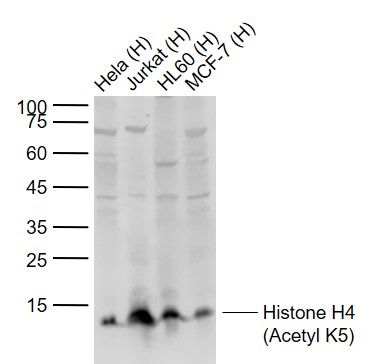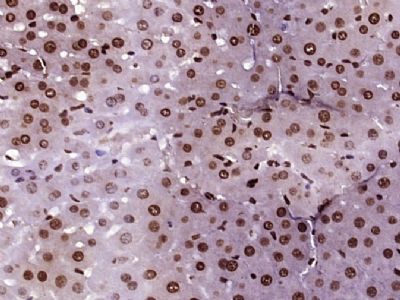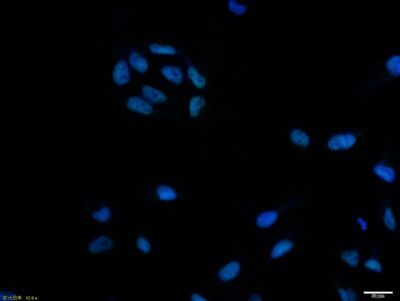Histones are basic nuclear proteins that are responsible for the nucleosome structure of the chromosomal fiber in eukaryotes. Nucleosomes consist of approximately 146 bp of DNA wrapped around a histone octamer composed of pairs of each of the four core histones (H2A, H2B, H3, and H4). The chromatin fiber is further compacted through the interaction of a linker histone, H1, with the DNA between the nucleosomes to form higher order chromatin structures. This gene is intronless and encodes a member of the histone H4 family. Transcripts from this gene lack polyA tails; instead, they contain a palindromic termination element. [provided by RefSeq, Jul 2008].
Function:
Core component of nucleosome. Nucleosomes wrap and compact DNA into chromatin, limiting DNA accessibility to the cellular machineries which require DNA as a template. Histones thereby play a central role in transcription regulation, DNA repair, DNA replication and chromosomal stability. DNA accessibility is regulated via a complex set of post-translational modifications of histones, also called histone code, and nucleosome remodeling.
Subunit:
The nucleosome is a histone octamer containing two molecules each of H2A, H2B, H3 and H4 assembled in one H3-H4 heterotetramer and two H2A-H2B heterodimers. The octamer wraps approximately 147 bp of DNA.
Subcellular Location:
Nucleus. Chromosome.
Post-translational modifications:
Acetylation at Lys-6 (H4K5ac), Lys-9 (H4K8ac), Lys-13 (H4K12ac) and Lys-17 (H4K16ac) occurs in coding regions of the genome but not in heterochromatin.
Citrullination at Arg-4 (H4R3ci) by PADI4 impairs methylation.
Monomethylation and asymmetric dimethylation at Arg-4 (H4R3me1 and H4R3me2a, respectively) by PRMT1 favors acetylation at Lys-9 (H4K8ac) and Lys-13 (H4K12ac). Demethylation is performed by JMJD6. Symmetric dimethylation on Arg-4 (H4R3me2s) by the PRDM1/PRMT5 complex may play a crucial role in the germ-cell lineage.
Monomethylated, dimethylated or trimethylated at Lys-21 (H4K20me1, H4K20me2, H4K20me3). Monomethylation is performed by SET8. Trimethylation is performed by SUV420H1 and SUV420H2 and induces gene silencing.
Phosphorylated by PAK2 at Ser-48 (H4S47ph). This phosphorylation increases the association of H3.3-H4 with the histone chaperone HIRA, thus promoting nucleosome assembly of H3.3-H4 and inhibiting nucleosome assembly of H3.1-H4.
Ubiquitinated by the CUL4-DDB-RBX1 complex in response to ultraviolet irradiation. This may weaken the interaction between histones and DNA and facilitate DNA accessibility to repair proteins. Monoubiquitinated at Lys-92 of histone H4 (H4K91ub1) in response to DNA damage. The exact role of H4K91ub1 in DNA damage response is still unclear but it may function as a licensing signal for additional histone H4 post-translational modifications such as H4 Lys-21 methylation (H4K20me).
Sumoylated, which is associated with transcriptional repression.
Crotonylation (Kcr) is specifically present in male germ cells and marks testis-specific genes in post-meiotic cells, including X-linked genes that escape sex chromosome inactivation in haploid cells. Crotonylation marks active promoters and enhancers and confers resistance to transcriptional repressors. It is also associated with post-meiotically activated genes on autosomes.
Similarity:
Belongs to the histone H4 family.
SWISS:
P62805
Gene ID:
8359
Database links:
Entrez Gene: 121504 Human
Entrez Gene: 554313 Human
Entrez Gene: 8294 Human
Entrez Gene: 8359 Human
Entrez Gene: 872 Human
Entrez Gene: 8361 Human
Entrez Gene: 8362 Human
Entrez Gene: 8363 Human
Entrez Gene: 8364 Human
Entrez Gene: 8365 Human
Entrez Gene: 8366 Human
Entrez Gene: 8367 Human
Entrez Gene: 8368 Human
Entrez Gene: 8370 Human
Entrez Gene: 100041230 Mouse
Entrez Gene: 100862646 Mouse
Entrez Gene: 319155 Mouse
Entrez Gene: 319156 Mouse
Entrez Gene: 319157 Mouse
Entrez Gene: 319158 Mouse
Entrez Gene: 319159 Mouse
Entrez Gene: 319160 Mouse
Entrez Gene: 319161 Mouse
Entrez Gene: 64332 Mouse
Entrez Gene: 326619 Mouse
Entrez Gene: 326620 Mouse
Entrez Gene: 69386 Mouse
Entrez Gene: 97122 Mouse
GenBank: NM_003548 Human
Omim: 142750 Human
SwissProt: P16840 Fruit fly (Drosophila melanogaster)
SwissProt: P02304 Human
SwissProt: P62805 Human
SwissProt: P02304 Mouse
SwissProt: P62806 Mouse
SwissProt: P02304 Rat
SwissProt: P09322 Schizosaccharomyces pombe
Unigene: 2300 Fruit fly (Drosophila melanogaster)
Unigene: 29514 Fruit fly (Drosophila melanogaster)
Unigene: 29527 Fruit fly (Drosophila melanogaster)
Unigene: 30219 Fruit fly (Drosophila melanogaster)
Unigene: 30220 Fruit fly (Drosophila melanogaster)
Unigene: 30221 Fruit fly (Drosophila melanogaster)
Unigene: 30223 Fruit fly (Drosophila melanogaster)
Unigene: 30868 Fruit fly (Drosophila melanogaster)
Unigene: 30869 Fruit fly (Drosophila melanogaster)
Unigene: 30871 Fruit fly (Drosophila melanogaster)
Unigene: 30872 Fruit fly (Drosophila melanogaster)
Unigene: 30873 Fruit fly (Drosophila melanogaster)
Unigene: 30876 Fruit fly (Drosophila melanogaster)
Unigene: 33873 Fruit fly (Drosophila melanogaster)
Unigene: 5747 Fruit fly (Drosophila melanogaster)
Unigene: 143080 Human
Unigene: 247816 Human
Unigene: 248172 Human
Unigene: 248178 Human
Unigene: 248179 Human
Unigene: 278483 Human
Unigene: 352191 Human
Unigene: 46423 Human
Unigene: 528055 Human
Unigene: 533295 Human
Unigene: 55468 Human
Unigene: 591790 Human
Unigene: 655235 Human
Unigene: 662174 Human
Unigene: 706635 Human
Unigene: 742244 Human
Unigene: 14775 Mouse
Unigene: 158272 Mouse
Unigene: 227295 Mouse
Unigene: 228709 Mouse
Unigene: 246720 Mouse
Unigene: 255646 Mouse
Unigene: 260530 Mouse
Unigene: 261642 Mouse
Unigene: 261662 Mouse
Unigene: 261664 Mouse
Unigene: 377875 Mouse
Unigene: 442307 Mouse
Unigene: 486099 Mouse
Unigene: 489077 Mouse
| Picture |
Sample:
Lane 1: Human Hela cell lysates
Lane 2: Human Jurkat cell lysates
Lane 3: Human HL60 cell lysates
Lane 4: Human MCF-7 cell lysates
Primary: Anti-Histone H4 (Acetyl K5) (SL10721R) at 1/1000 dilution
Secondary: IRDye800CW Goat Anti-Rabbit IgG at 1/20000 dilution
Predicted band size: 11 kD
Observed band size: 11 kD
Paraformaldehyde-fixed, paraffin embedded (rat liver tissue); Antigen retrieval by boiling in sodium citrate buffer (pH6.0) for 15min; Block endogenous peroxidase by 3% hydrogen peroxide for 20 minutes; Blocking buffer (normal goat serum) at 37°C for 30min; Antibody incubation with (H4 (Acetyl K5)) Polyclonal Antibody, Unconjugated (SL10721R) at 1:400 overnight at 4°C, followed by operating according to SP Kit(Rabbit) (sp-0023) instructionsand DAB staining.
Hela cell; 4% Paraformaldehyde-fixed; Triton X-100 at room temperature for 20 min; Blocking buffer (normal goat serum, SLC0005) at 37°C for 20 min; Antibody incubation with (Histone H4 (Acetyl K5)) polyclonal Antibody, Unconjugated (SL10721R) 1:100, 90 minutes at 37°C; followed by a conjugated Goat Anti-Rabbit IgG antibody at 37°C for 90 minutes, DAPI (blue, C02-04002) was used to stain the cell nuclei.
|
|
|


